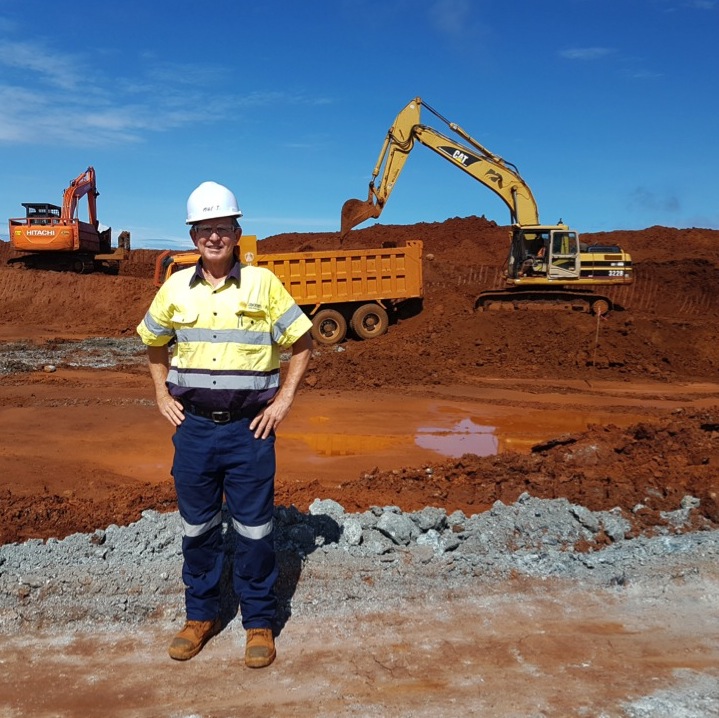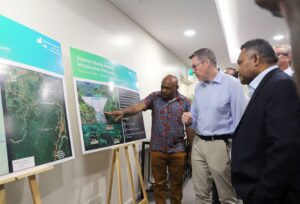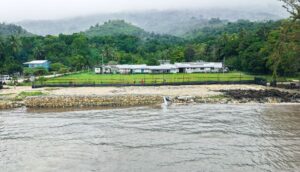AXIOM mining company is making steady headway towards improving the conditions at its nickel mine site camp on San Jorge.
The company is making sure it maintains the highest standard in environmental safety as it progresses with the extraction of nickel ore on the uninhabited island in Isabel Province.
They are now progressing well with the nickel ore mining operations; stockpiling nickel ore into different geological classes.
Nickel ores are composed of two kinds of minerals; one is limonite, which is used, in hydrometallurgical processes and the other is saprolite that is processed by smelting to obtain nickel products. As limonite lies closer to the earth surface, the extraction of limonite precedes that of saprolite. Both are necessary and in-demand ingredients for many industries.
Axiom San Jorge Nickel Mine Manager Michael James said Axiom is committed to further improving the living conditions at its San Jorge camp and continuing to maintain and develop high standards in environmental safety for its entire operation. The company has invested substantial resources to that effect.
The Australian mining expert has spent the past 30 years of his career working in the international mining business. He has just finished establishing a large gold mine in the Philippines before joining Axiom. James has also previously worked in Papua New Guinea building mines.
As Mine Manager, James is responsible to ensure that the living conditions for the company’s mine site workers are up to the required standard and that necessary environmental and safety controls are put in place. He takes those responsibilities very seriously.
Explaining the camp accommodation improvements achieved so far, Mr James said: “We’ve had new water catchment drains put in and cleaned up all the surrounds of the camp for replanting of trees and groundcovers (plants).
“The camp is designed in a way that all rain water that runs off the camp is collected in one area. Previously, there was only one sediment dam to collect water and silts but now, we have three large dams in sequence.”
“Outlying areas such as the stockpile pads have in place their own sediment dams and sumps to collect run-off silts. All sediment controls will be cleaned out on a regular basis. Re- planting of ground covers will minimise the quantity of silts collected during rain events. This will prevent dirty water entering the ocean and fishing grounds.
“We’re continuing to improve the water supply. We’ve identified a clean water source and sent water samples to the Solomon Islands Water Authority for consumption safety guarantee testing.
James added that, “We’ve also improved the power supply by increasing the generators in service. Now we have a better power supply for kitchen use, camp lighting, computers, internet and all activities within the camp premises. It is safe to walk around at night due to improved lighting systems.
“We’re aiming to set up a recreational area to keep workers morale high. We’re also reviewing the kitchen menu with the intention of meeting workers nutritional needs as the work on site gets more intense.”
The Fuel storage area has earth mounds in place with channels and sumps, in case of any accidental spillage of fossil fuels. It can then be easily collected and correctly disposed to maintain environmental standards.
Explaining the environmental safety control measures for the actual mining operation, James said: “We’ve reviewed the previous mine plan and modified it to achieve faster ore supply in the short-term, whilst also increasing the sediment catchment control dams for the work areas from one dam to three dams.
“The modified plan will also allow us to reduce the amount of ground displacement in the short term as the mine site will be split into zones and progressively rehabilitated as mining continues. Minimising these areas in the short term allows us to plan and design with support and communication from the local communities so we can put in place the best rehabilitation methodologies.”
James said large sediment dams and drainage channels have been placed within the proposed pit areas to expedite mining at a later date.
“A primary area is the ore collection sector of the mine site. We have bunds and drainage channels in place to minimise sediment run-off. Once mining is finished in a particular zone, we will be re-planting any displaced areas and progressively replanting the mined areas that have been affected. We will be able to mine and rehabilitate areas at the same time.
He said all mining areas, roads, stockpiles and mine pits have drains and sediment controls in place, adding that it is a matter of high priority to establish environmental safety controls before any disturbance to the natural flora.
James said that upon joining Axiom, he was impressed with the company’s corporate philosophy of ‘Build, Protect and Serve’ and its operating standards designed to the strict compliance and high standards demanded by Solomon Islands law and the mining practices that are necessary for sustainable development in the communities in which it works.
Source: Axiom Media




